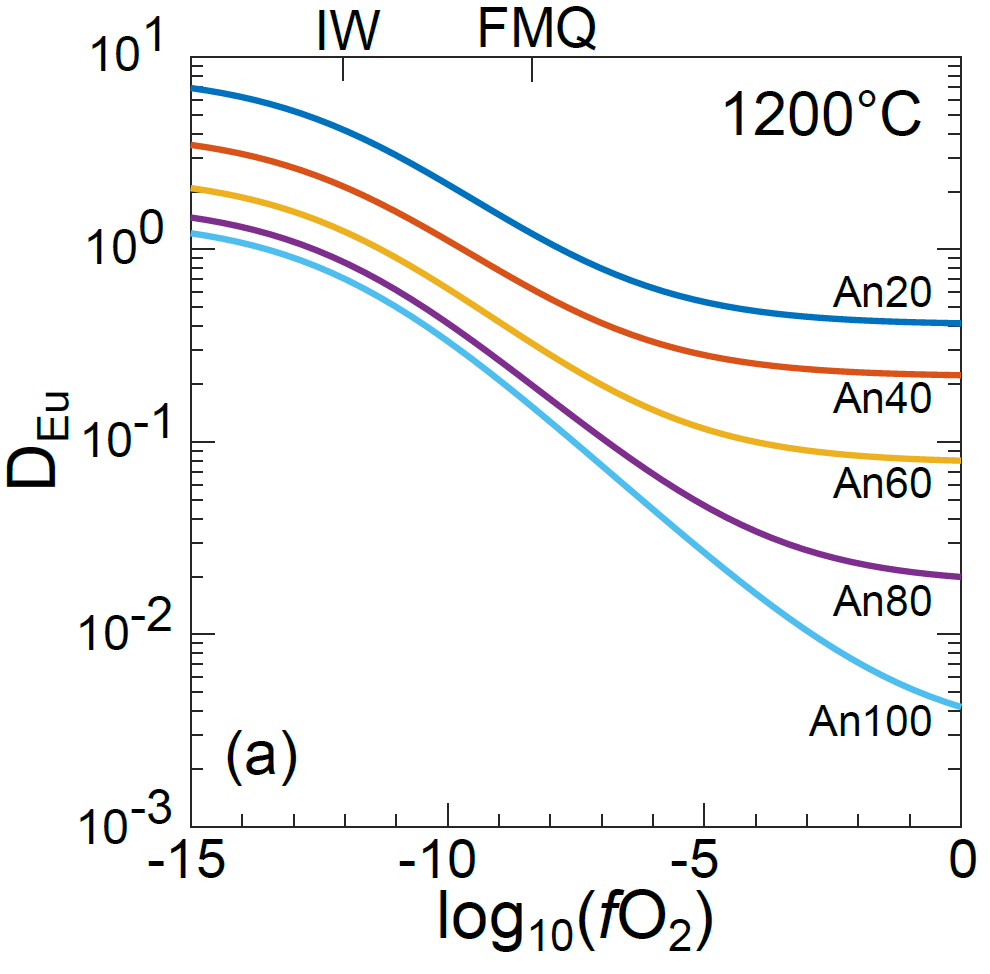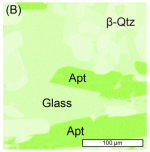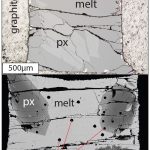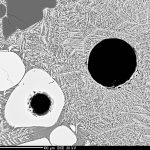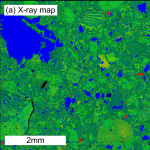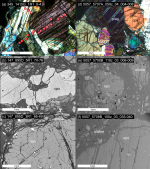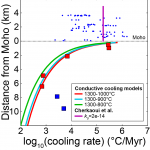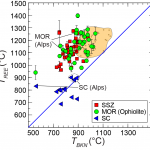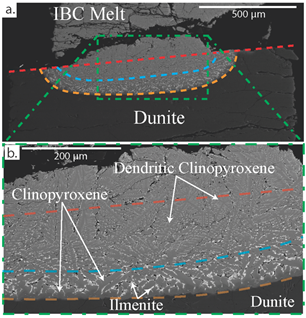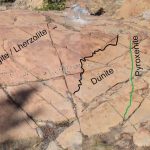‡ indicates graduate student supervised by Dygert; † undergraduate; § postdoc
Trace Element Partitioning: Constraints on the Dynamic Evolution of Earth and Planetary Interiors
Partition coefficients are fundamental tools used by petrologists and geochemists to understand igneous processes such as partial melting, melt migration, and element and isotope fractionation. High-pressure, high temperature experiments are conducted in the piston cylinder apparatus to measure partition coefficients under geologically-relevant conditions.
Eu-based mineral-melt and mineral-mineral oxybarometers
Dygert, Draper, Rapp, Lapan, Fagan, Neal, Geochimica et Cosmochimica Acta (2020)
Eu is a multivalent element whose partitioning behavior is strongly dependent on oxygen fugacity (fO2). Using new experimental data and a compilation of published work, we developed a model to predict plagioclase-melt Eu partitioning as a function of fO2. The model can be applied as an oxybarometer, and recovers fO2s for MORBs consistent with determinations by XANES and other methods.
Dygert, Ustunisik, Nielsen, Nature Communications (2024)
Application of the plagioclase-melt oxybarometer to plagioclase-hosted melt inclusions revealed correlations between geochemical indices of depletion and fO2, suggesting that partial melting reduces Earth’s mantle by fractionating trivalent from divalent iron.
Dygert, ‡Ji, ‡Etheridge, Geochimica et Cosmochimica Acta (2025)
An fO2-dependent clinopyroxene-melt Eu partitioning model and a Eu-in-plagioclase-clinopyroxene oxybarometer. Calculator spreadsheet and code archived here.
An experimental study of apatite-melt trace element partitioning
‡Ji and Dygert, Geochimica et Cosmochimica Acta (2024)
This study presents new apatite-melt trace element partitioning experiments for fluorapatite, hydroxyapatite, and chlorapatite. Predictive trace element partitioning models and apatite-melt and apatite-plagioclase oxybarometers are developed. Kinetic analysis evaluates the effect of subsolidus reequilibration on recovered oxygen fugacities.
Trace element partitioning between augite and Fe-rich basalts
‡Mouser and Dygert, LPSC (2022)
Dygert, Liang, Sun, Hess, Geochimica et Cosmochimica Acta (2014)
Trace element partitioning between Fe–Ti oxides and lunar basalts
Dygert, Liang, Hess, Geochimica et Cosmochimica Acta (2013)
Fe-Ti oxides and Fe-rich clinopyroxenes are phases relevant to evolved planetary interiors. These systems are understudied but important for layered intrusions on Earth, Martian systems, the angrite parent body, and the Moon, and are being newly constrained in experimental work. Lunar magma ocean crystallization models that incorporate insights from the experimental observations suggest REE fractionation during magma ocean crystallization was not efficient enough to produce a residual liquid with REE concentrations similar in slope to the lunar basalts. Dense, late lunar magma ocean cumulates were likely mixed back into the underlying cumulate mantle (by a process called cumulate overturn) and then partially melted to generate the observed trace element patterns.
Thermometric and Speedometric Constraints on the Evolution of Earth’s Lithosphere and Asteroids
Geothermometers rely on temperature sensitive element partitioning among a mineral assemblage. Because trivalent rare earth elements (REEs) diffuse more slowly than divalent major elements, REE-based thermometers often record near-magmatic temperatures where major element thermometers record lower cooling temperatures. We use REE thermometry to decode the thermal histories of samples from the crust and mantle, and meteorites.
High-temperature thermal histories of meteorite parent asteroids: Evidence for early multistage metamorphism
§Anzures, Dygert, §Lucas, LPSC (2022)
§Lucas, Dygert, Ren, Hesse, Miller, McSween, Meteoritics and Planetary Science (2022)
§Lucas, Dygert, Ren, Hesse, Miller, McSween, Geochimica et Cosmochimica Acta (2020)
Application of the REE-in-two-pyroxene and major element-based thermometers to H, L and LL chondrites, acapulcoites-lodranites, and winonaite-IAB iron meteorites suggests that all five parent bodies were quenched by catastrophic fragmentation at high temperature. Fast cooling rates through high-temperature intervals stand in contrast to cooling rates orders of magnitude slower through lower temperature intervals. The observations can be reconciled if after fragmentation, the parent bodies reaccreted to form slow-cooling rubble pile asteroid. These results demonstrate that catastrophic collisions in the early Solar System were more frequent than previously recognized.
Thermal histories and formation of oceanic lithosphere beneath spreading centers
‡Grambling, Dygert, †Boring, Jean, Kelemen, JGR – Solid Earth (2022)
Using a battery of major and trace-element based thermometers and speedometers, we explore the thermal history of oceanic lithosphere (crust and mantle) formed beneath fast-spreading ridges (Hess Deep and the Samail ophiolite). We find the crust-mantle transition zone was quenched from near-peak temperatures, consistent with vigorous hydrothermal cooling and the Sheeted Sills model of oceanic crustal accretion. This work was made possible through participation in the Oman Drilling Project (Dygert, Grambling, Kelemen [PI]).
Dygert, Kelemen, Liang, Earth and Planetary Science Letters (2017)
Despite originating from very different tectonic settings, many abyssal and ophiolitic peridotites have similar thermal histories. The Samail ophiolite has a thick crustal section and probably formed beneath a fast spreading center; abyssal peridotites are from fracture zones and amagmatic ridges that lack crust. The similar thermal histories suggest that cooling is independent of spreading rate and the presence or absence of crust. This work investigated spatial variations in cooling rate in the Samail ophiolite mantle section, observing fast cooling rates at the crust-mantle boundary and a systematic decrease in cooling rate with depth moving into the mantle section, consistent with hydrothermal cooling of the crust and conductive cooling of the mantle.
Temperatures and cooling rates recorded in REEs in ophiolitic and abyssal peridotites
Dygert and Liang, Earth and Planetary Science Letters (2015)
Ophiolites are fragments of oceanic lithosphere obducted onto continental margins. I explored the global temperature systematics among ophiolitic peridotites, finding that those with a strong subduction influence were initially colder and cooled more slowly than peridotites dredged from abyssal basins. Subduction appears to profoundly influence the thermal regime beneath spreading centers.
Rheological Properties of Earth and Planetary Materials
In their earliest stages of evolution, terrestrial planets had deep magma oceans. Cooling magma oceans crystallize a stratified cumulate pile with abrupt lithological variations and more gradual compositional variations. What are the rheologies of mantle minerals and the multiphase aggregates they are composed of? What are the consequences for mantle convection? How does compositional layering shape the long term physical and chemical evolution of planets?
Ilmenite and ilmenite-olivine aggregates: Implications for lunar dynamic evolution
Lunar basalts are Ti-rich, suggesting that ilmenite is an abundant component of the Moon’s mantle. We measured the rheological properties of ilmenite and ilmenite-geikielite solid solutions for the first time in a Griggs deformation apparatus, and developed flow laws that can be implemented in dynamic models. Extrapolating to mantle conditions, we find that ilmenite is >3 orders of magnitude weaker than olivine. Small amounts of ilmenite may significantly weaken the lunar mantle, resulting in the development of dense downwelling Rayleigh-Taylor instabilities during or after magma ocean crystallization. In the extreme case, such instabilities may be hemispheric, explaining asymmetrical properties of the Moon such as the concentration of high-Ti basalts on the nearside.
Experiments
‡Grambling, Tokle, Dygert, Hirth, Chin, Liang, Meyers, LPSC (2022)
Tokle, Hirth, Raterron, Liang, Dygert, Journal of Geophysical Research – Planets (2021)
Dygert, Hirth, Liang, Geophysical Research Letters (2016)
Models
Li, Zhang, Liang, Wu, Dygert, Huang, Parmentier, Journal of Geophysical Research – Planets (2019)
Zhang, Dygert, Liang, Parmentier, Geophysical Research Letters (2017)
Viscosity of magma ocean liquids: Implications for differentiation of Mercury and the Moon
We measured the viscosity of S-bearing and S-free mercurian magma ocean analogue liquids. The viscosities of these liquids would promote fractional crystallization, suggesting Mercury’s cumulate mantle was dynamically mixed after magma ocean solidification.
‡Mouser and Dygert, Journal of Geophysical Research – Planets (2023)
Building on our experimental results, we evaluated the physical evolution of Mercury’s mantle after the magma ocean stage.
Dygert, Lin, Marshall, Kono, Gardner, Geophysical Research Letters (2017)
The anorthitic lunar crust formed by flotation of positively buoyant plagioclase on the crystallizing lunar magma ocean. Experimental measurements of the magma ocean liquid viscosity and a crustal compaction model suggest formation of a pure lower lunar crust beneath a more impure older crust.
Insights into rheological properties of Earth’s lower lithosphere from deformed mantle xenoliths
Dygert, Bernard, Behr, Geochemistry, Geophysics, Geosystems (2019)
Mylonitic mantle xenoliths from Lunar Crater volcanic field, central Nevada record chemical signatures and temperatures suggesting they originate from the base of the lithosphere. Recrystallized olivine grains demonstrate isochemical deformation and differential stress magnitudes of ~50MPa. Anomalies in shear-wave splitting orientations and magnitudes, seismic body wave velocities, heat flow, and topography suggest the presence of a downwelling Rayleigh-Taylor (R-T) instability beneath the volcanic field. We infer that the mylonites directly sample the detaching R-T instability.
Melt Migration and Melt-Rock Reaction
Terrestrial and lunar basalts share a fascinating property: they are not in chemical equilibrium with mantle rock at low pressures. How are melts transported through dozens to hundreds of kilometers of mantle while remaining chemically insulated? To what extent do melts react with ambient mantle beneath mid-ocean ridges? How is melt-rock reaction expressed in basalts and mantle cumulates?
Melt-rock reaction in the lunar mantle
‡Scholpp and Dygert, CMP (2024)
Late lunar magma ocean cumulates have low melting temperatures and high concentrations of heat-producing elements. They are thought to have sank into underlying mantle as Rayleigh-Taylor instabilities. We experimentally explore reactions between magma ocean cumulate melts and lunar interior phases, observing dissolution-precipitation reactions that would produce hybridized lunar mantle sources. These could melt to form mare basalts and provide a means to test dynamic models of early lunar evolution.
Plate tectonic cycling modulates Earth’s 3He/22Ne ratio
Dygert, Jackson, Hesse, Tremblay, Shuster, †Gu, Earth and Planetary Science Letters (2018)
The MORB mantle has distinctly higher 3He/22Ne compared to the OIB source mantle. He diffusion in mantle rock may be orders of magnitude faster than Ne at mantle temperatures. Preferential 3He ingassing around dunite channels will increase the 3He/22Ne of the depleted mantle. Integrating this intuitive theoretical framework into a mixing model, we estimate mantle mixing timescales on the order of 400 million-billions of years. Our model suggests mantle convection is not and could not have been layered for most of geologic time.
Multiple episodes of melt percolation and melt-rock reaction at Trinity ophiolite, northern California
Dygert, Liang, Kelemen, Journal of Petrology (2016)
Tabular dunite bodies (“dunite channels”) are thought to represent efficient pathways for melt extraction from the mantle. This study investigates trace element variations across a dunite-harzburgite-lherzolite-plagioclase lherzolite sequence at the Trinity ophiolite, demonstrating that tabular dunites can be sources of melt infiltration rather than melt extraction pathways, opposite the dunite channel paradigm.
Melt rock reaction: compositional controls on reaction products
Wang, Liang, Dygert, Xu, Contributions to Mineralogy and Petrology (2016)
Wang, Liang, Xu, Dygert, Contributions to Mineralogy and Petrology (2013)
These publications present experimental results that can help field geologists interpret the conditions under which dunites, orthopyroxenites, and other lithologies form by melt-rock reaction in the mantle.
